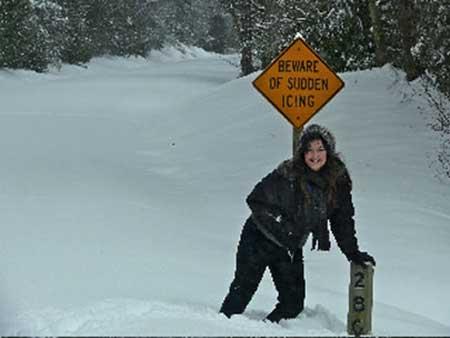For travelers and emergency workers in much of the country, any dreams of a "White Christmas" will likely be remembered as bad ones this year. Many parks have been impacted by recent storms, but among the hardest hit are the Blue Ridge Parkway and Cumberland Gap National Historical Park.
The challenges at the Blue Ridge Parkway are compounded by the sheer number of miles of road that need to be cleared. According to information from the park,
The Blizzard of 2009 dumped from 10 to 30 inches of snow along the entire length of the 469-mile-long parkway. High winds, particularly in the northern districts, have created snow drifts as much as six to eight feet deep, which require the use of front-end loaders and back-hoes in conjunction with snow plow equipment to clear administrative access to park duty stations. Numerous fallen trees are further complicating snow-removal operations.
Almost all of the Parkway remains closed to vehicles today, although the park headquarters and visitor center in Asheville, North Carolina, are open and the Peaks of Otter Lodge in Virginia is open via State Route 43.
Motorists are urged to respect those closures and stay off of the road for safety reasons. Rangers have limited ability to identify and respond to stranded motorist emergencies. Protection rangers are working with Virginia and North Carolina State Highway Patrol officers to receive information from flyovers.
You can obtain recorded updates on road conditions in the park by calling (828) 298 0398.
At Cumberland Gap National Historical Park, located at the point where Virginia, Kentucky and Tennessee converge, the park is still working to restore basic operations after last week's storm.
Park staff and contractors continue cleaning up park roads and facilities, with the primary goal of opening up Route 988 through the park and reestablishing power to park buildings.
Emergency contracts have been established to provide extra sawyers and arrange for hauling and chipping to manage the large number of trees removed from park roads. Park staff continues to work to clear the roads and hazard trees, with plans to attempt a complete survey of the park’s trails and facilities in the week after the Christmas holiday.
The storm began dropping snow on the park on Friday afternoon, December 18. By 8 p.m. that night, the short stretch of Route 25E through the Cumberland Gap Tunnel was blocked by vehicle accidents, and reports were arriving of visitors trapped by downed trees on Route 988 through the park.
While rangers cleared the highway to allow snowplows to clear the road, a team of maintenance employees and rangers cut their way through more than a hundred downed trees to reach the visitors. Several park buildings were damaged and lost electrical power, but there were no injuries to either visitors or staff.
If you're considering a trip to the area, check with the park visitor center at 606-248-2817 for updates about efforts to reopen roads and trails in the park.




Add comment